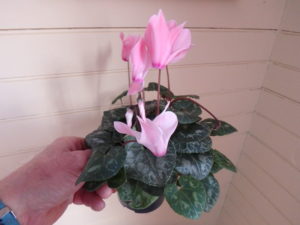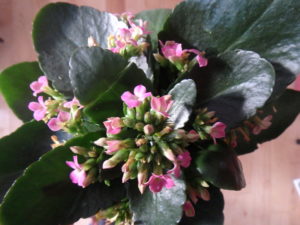Four Great Plants to Brighten Up Your House
Winter is tough on many gardeners, myself included. We need flowers blooming and plants to tend. But many of us are not enthralled with standard houseplants because they are often fussy and, if over-watered, too easy to kill. Let me suggest some nice easy, disposable flowers you can get at your local nursery or food coop.
I recently bought 3 blooming primroses for a total of $11.85. One is purple, the others shades of pink. They will bloom for a couple of weeks – or perhaps more. The tags only said ”Primula” (its scientific genus) and “Plant in part shade 8” apart”. The tag did not say, however, if these primroses would survive a New England winter. I suspect not, having babied other grocery store primroses along until the ground thawed and planted them outside. But I don’t care. These lovely plants will provide color and life indoors at a drab time of the year. And for less than $4 each, they don’t have to last forever.
What the tag should have said, however, is “Do not keep this primrose in a hot, sunny window unless you are willing to water regularly.” The soil they are in dries out fast, and you can cook a primrose – and most other grocery store plants – in just a day or two of inattention. I did that recently, but I placed the abused primrose in a deep dish and filled it with water, allowing it to suck up plenty. And it recovered in just a few hours.
I usually add a few drops of a product called “Superthrive” to the water when I have a plant that is suffering from neglect. This liquid contains plant hormones and seaweed extracts, and is very good for helping plants recover from environmental stress. It is expensive if calculated by the ounce, but so little is needed that it is not expensive. And it works. A 4 ounce bottle costs around $10-12.
I also bought a cyclamen in my effort to brighten up the house and do some attitude adjustment. Cyclamen definitely do not want to be in a sunny window. Bright indirect light is best. They come in a range of pinks, reds, magentas and white. I tell when they need watering by lifting the pot. If it feels very light, it’s time to give it water.
Cyclamen keep on blooming for much longer than primroses, and can last for years, getting bigger and better each year. If you want to learn about getting them to re-bloom, find a copy of Thalassa Cruso’s wonderful book, Making Things Grow: A Practical Guide for the Indoor Gardener. It’s out of print, but readily available. Every used bookstore has copies, and it’s a gem. Ms. Cruso was a TV personality, I gather, and her books read the way she must have presented herself – as a friendly, knowledgeable auntie.
Thalassa Cruso was, of course, a plant fanatic. I’m not sure that following every bit of her advice is worth the trouble. She notes that cyclamen come originally from Iran where they bloom in winter. She claimed to move hers every evening to a cool spot such as a mudroom where the temperature is below 60 degrees. My goodness, it’s enough for me to turn off all the lights, feed the woodstove and the cat, take out the dog and brush my teeth before going to bed. Now I learn I should be moving the cyclamen, too!
Cineria is another gem available at this time of year. It has the added advantage of a lovely fragrance, too. It appears as a mound of daisy-like flowers that stand up a good 10 inches. It wants bright light, but no direct sunshine (they will finish up too quickly in the sun). Its soil needs to be kept moist, but not soggy.
Cineria are true annuals. That means that once the 6-weeks of blooming is over, the plant is done. You cannot get it to survive, year after year, returning to bloom again. That’s a blessing. You can feel fine about throwing it in the compost. It’s a no-guilt plant.
The last of my recent investments was a kalanchoe. This is a succulent and does will in warm, dry conditions. It comes in a variety of colors. In Thalassa Cruso’s book it was described in the chapter “Neglectable Plants”. That means, I suppose, it is hard to kill them. This one will, apparently, re-bloom if you cut it back after blooming, and reduce the light for a month, and don’t water it then, either.
So go get some plants in bloom for the house. No matter what you do, they should last longer than the same money invested in cut flowers, so they are a good investment. Just don’t think of them as a lifetime investment and you’ll be happy. Let them bloom, and toss them if you wish. I often do.
Read Henry’s blog twice a week at https://dailyuv.com/





